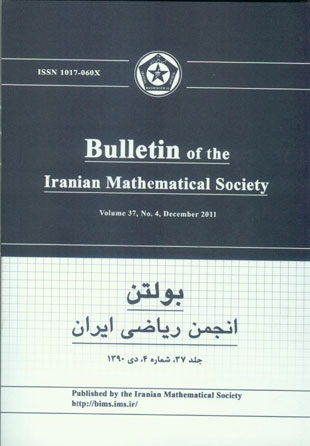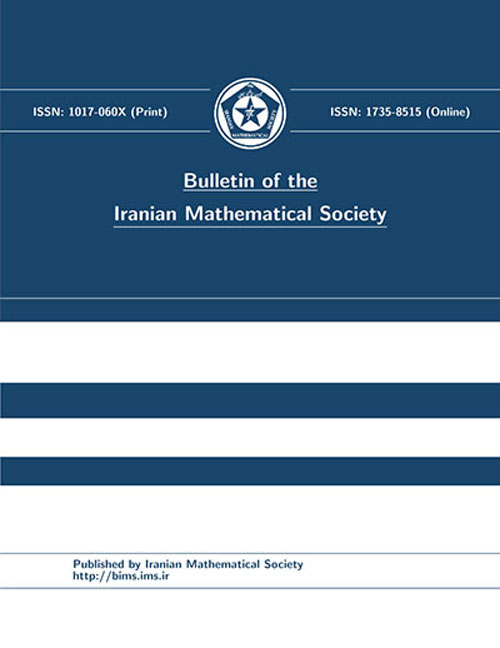فهرست مطالب

Bulletin of Iranian Mathematical Society
Volume:37 Issue: 4, 2011
- تاریخ انتشار: 1391/02/23
- تعداد عناوین: 19
-
-
Page 1Here, a Finsler manifold $(M,F)$ is considered with corresponding curvature tensor, regarded as $2$-forms on the bundle of non-zero tangent vectors. Certain subspaces of the tangent spaces of $M$ determined by the curvature are introduced and called $k$-nullity foliations of the curvature operator. It is shown that if the dimension of foliation is constant, then the distribution is involutive and each maximal integral manifold is totally geodesic. Characterization of the $k$-nullity foliation is given, as well as some results concerning constancy of the flag curvature, and completeness of their integral manifolds, providing completeness of $(M,F)$. The introduced $k$-nullity space is a natural extension of nullity space in Riemannian geometry, introduced by Chern and Kuiper and enlarged to Finsler setting by Akbar-Zadeh and contains it as a special case.
-
Page 19Relative to a hereditary torsion theory $tau$ we introduce a dimension for a module $M$, called {em $tau$-rank of} $M$, which coincides with the reduced rank of $M$ whenever $tau$ is the Goldie torsion theory. It is shown that the $tau$-rank of $M$ is measured by the length of certain decompositions of the $tau$-injective hull of $M$. Moreover, some relations between the $tau$-rank of $M$ and complements to $tau$-torsionfree submodules of $M$ are obtained.
-
Page 35A characteriation of continuity of the $p$-$Lambda$-variation function is given and the Helly's selection principle for $Lambda BV^{(p)}$ functions is established. A characterization of the inclusion of Waterman-Shiba classes into classes of functions with given integral modulus of continuity is given. A useful estimate on modulus of variation of functions of class $Lambda BV^{(p)}$ is found.
-
Page 51In this paper we introduce the notion of classical quasi-primary submodules that generalizes the concept of classical primary submodules. Then, we investigate decomposition and minimal decomposition into classical quasi primary submodules. In particular, existence and uniqueness of classical quasi-primary decompositions in finitely generated modules over Noetherian rings are proved. Moreover, we show that this decomposition and the decompositioninto classical primary submodules are the same when $R$ is a domain with ${rm dim}(R)leq 1$.
-
Page 73Among the six classes of pro-2-groups of finite and fixed co-classes and trivial Schur Multiplicator which studied by Abdolzadeh and Eick in 2009, there are two classes $$S_5=langle a,bmid [b,a^2]=1, a^2=[b,a]^2, (b^2)^{[b,a]}b^2=1rangle$$ and $$S_6=langle a,t,bmid a^2=b^2,[b,a]^2=1, t^a=t^{-1}[b,a], b^t=abarangle$$that have been conjectured to have deficiency zero presentations. In this paper we prove these conjectures. This completes the efficiency of all six classes of pro-$2$-groups of fixed co-classes.
-
Page 81Let $mathcal{A}$ be a Banach algebra and $mathcal{M}$ be a Banach $mathcal{A}$-bimodule. We say that a linear mapping $delta:mathcal{A} rightarrow mathcal{M}$ is a generalized $sigma$-derivation whenever there exists a $sigma$-derivation $d:mathcal{A} rightarrow mathcal{M}$ such that $delta(ab) = delta(a)sigma(b) + sigma(a)d(b)$, for all $a,b in mathcal{A}$. Giving some facts concerning generalized $sigma$-derivations, we prove that if $mathcal{A}$ is unital and if $delta:mathcal{A} rightarrow mathcal{A}$ is a generalized $sigma$-derivation and there exists an element $a in mathcal{A}$ such that emph{d(a)} is invertible, then $delta$ is continuous if and only if emph{d} is continuous. We also show that if $mathcal{M}$ is unital, has no zero divisor and $delta:mathcal{A} rightarrow mathcal{M}$ is a generalized $sigma$-derivation such that $d(textbf{1}) neq 0$, then $ker(delta)$ is a bi-ideal of $mathcal{A}$ and $ker(delta) = ker(sigma) = ker(d)$, where textbf{1} denotes the unit element of $mathcal{A}$.
-
Page 95ardy and Littlewood conjectured that every large integer $n$ that is not a square is the sum of a prime and a square. They believed that the number $mathcal{R}(n)$ of such representations for $n = p+m^2$ is asymptotically given by begin{equation*} mathcal{R}(n) sim frac{sqrt{n}}{log n}prod_{p=3}^{infty}left(1-frac{1}{p-1}left(frac{n {p}right)right), end{equation*} where $p$ is a prime, $m$ is an integer, and $left(frac{n}{p}right)$ denotes the Legendre symbol. Unfortunately, as we will later point out, this conjecture is difficult to prove and not emph{all} integers that are nonsquares can be represented as the sum of a prime and a square. Instead in this paper we prove two upper bounds for $mathcal{R (n)$ for $n le N$. The first upper bound applies to emph{all} $n le N$. The second upper bound depends on the possible existence of the Siegel zero, and assumes its existence, and applies to all $N/2 < n le N$ but at most $ll N^{1-delta_1}$ of these integers, where $N$ is a sufficiently large positive integer and $0Page 109In this paper, we introduce a method by which we can find a close connection between the set of prime $z$-ideals of $C(X)$ and the same of $C(Y)$, for some special subset $Y$ of $X$. For instance, if $Y=Coz(f)$ for some $fin C(X)$, then there exists a one-to-one correspondence between the set of prime $z$-ideals of $C(Y)$ and the set of prime $z$-ideals of $C(X)$ not containing $f$. Moreover, considering these relations, we obtain some new characterizations of classical concepts in the context of $C(X)$. For example, $X$ is an $F$-space if and only if the extension $Phi: beta Yrightarrowbeta X$ of the identity map $imath: Yrightarrow X$ is one-to-one, for each $z$-embedded subspace $Y$ of $X$. Supposing $p$ is a non-isolated $G_delta$-point in $X$ and $Y=Xsetminus{p}$, we prove that $M^p(X)$ contains no non-trivial maximal $z$-ideal if and only if $pinbe X$ is a quasi $P$-point if and only if each point of $beta Y setminus Y$ is a $P$-point with respect to $Y$.Page 127For two algebras $A$ and $B$, a linear map $T:A longrightarrow B$ is called separating, if $xcdot y=0$ implies $Txcdot Ty=0$ for all $x,yin A$. The general form and the automatic continuity of separating maps between various Banach algebras have been studied extensively. In this paper, we first extend the notion of separating map for module case and then we give a description of a linear separating map $T:B longrightarrow X$, where $B$ is a unital commutative semisimple regular Banach algebra satisfying the Ditkin's condition and $X$ is a left Banach module over a unital commutative Banach algebra. We also show that if $X$ is hyper semisimple and $T$ is bijective, then $T$ is automatically continuous and $T^{-1}$ is separating as well.Page 141In this paper we introduce and study Besselian $g$-frames. We show that the kernel of associated synthesis operator for a Besselian $g$-frame is finite dimensional. We also introduce $alpha$-dual of a $g$-frame and we get some results when we use the Hilbert-Schmidt norm for the members of a $g$-frame in a finite dimensional Hilbert space.Page 157Let $S$ be an inverse semigroup and let $E$ be its subsemigroup of idempotents. In this paper we define the $n$-th module cohomology group of Banach algebras and show that the first module cohomology group $HH^1_{ell^1(E)}(ell^1(S),ell^1(S)^{(n)})$ is zero, for every odd $ninmathbb{N}$. Next, for a Clifford semigroup $S$ we show that $HH^2_{ell^1(E)}(ell^1(S),ell^1(S)^{(n)})$ is a Banach space, for every odd $ninmathbb{N}$.Page 171Let $A$ be a Banach algebra and $X$ be a Banach $A$-bimodule. Then ${mathcal{S}}=A oplus X$, the $l^1$-direct sum of $A$ and $X$ becomes a module extension Banach algebra when equipped with the algebra product $(a,x).(a',x')=(aa',ax'+xa').$ In this paper, we investigate biflatness and biprojectivity for these Banach algebras. We also discuss on automatic continuity of derivations on ${mathcal{S}}=Aoplus A$.Page 185In this paper, several $Delta$ and strong convergence theorems are established for the Ishikawa iterations for nonexpansive mappings in the framework of CAT(0) spaces. Our results extend and improve the corresponding results.Page 199A space $Y$ is called an {em extension} of a space $X$, if $Y$ contains $X$ as a dense subspace. Two extensions of $X$ are said to be {em equivalent}, if there is a homeomorphism between them which fixes $X$ point-wise. For two (equivalence classes of) extensions $Y$ and $Y'$ of $X$ let $Yleq Y'$, if there is a continuous function of $Y'$ into $Y$ which fixes $X$ point-wise. An extension $Y$ of $X$ is called a {em one-point extension}, if $Ybackslash X$ is a singleton. An extension $Y$ of $X$ is called {em first-countable}, if $Y$ is first-countable at points of $Ybackslash X$. Let ${mathcal P}$ be a topological property. An extension $Y$ of $X$ is called a {em ${mathcal P}$-extension}, if it has ${mathcal P}$. In this article, for a given locally compact paracompact space $X$, we consider the two classes of one-point v{C}ech-complete; ${mathcal P}$-extensions of $X$ and one-point first-countable locally-${mathcal P}$ extensions of $X$, and we study their order structures, by relating them to the topology of a certain subspace of the outgrowth $beta Xbackslash X$. Here ${mathcal P}$ is subject to some requirements and include $sigma$-compactness and the Lindel"{o}f property as special cases.Page 229This paper is concerned with the best proximity pair problem in Hilbert spaces. Given two subsets $A$ and $B$ of a Hilbert space $H$ and the set-valued maps $F:Ato 2^ B$ and $G:A_0to 2^{A_0}$, where $A_0={xin A: |x-y|=d(A,B)~~~mbox{for some}~~~ yin B}$, best proximity pair theorems provide sufficient conditions that ensure the existence of an $x_0in A$ such that $$d(G(x_0),F(x_0))=d(A,B).$$Page 235Let $G$ be a $p$-group of nilpotency class $k$ with finite exponent $exp(G)$ and let $m=lfloorlog_pkrfloor$. We show that $ex (M^{(c)}(G))$ divides $exp(G)p^{m(k-1)}$, for all $cgeq1$, where $M^{(c)}(G)$ denotes the c-nilpotent multiplier of $G$. This implies that $exp(M(G))$ divides $exp(G)$, for all finite $p$-groups of class at most $p-1$. Moreover, we show that our result is an improvement of some previous bounds for the exponent of $M^{(c)}(G)$ given by M. R. Jones, G. Ellis and P. Moravec in some cases.Page 243In this paper, we show that every element of a discrete module is a sum of two units if and only if its endomorphism ring has no factor ring isomorphic to $Z_{2}$. We also characterize unit sum number equal to two for the endomorphism ring of quasi-discrete modules with finite exchange property.Page 251We observe some new characterizations of $n$-presented modules. Using the concepts of $(n,0)$-injectivity and $(n,0)$-flatness of modules, we also present some characterizations of right $n$-coherent rings, right $n$-hereditary rings, and right $n$-regular rings.Page 269This paper considers the search problem, introduced by Srivastava cite{Sr}. This is a model discrimination problem. In the context of search linear models, discrimination ability of search designs has been studied by several researchers. Some criteria have been developed to measure this capability, however, they are restricted in a sense of being able to work for searching only one possible nonzero effect. In this paper, two criteria are proposed, based on Kullback-Leibler distance. These criteria are able to evaluate the search ability of designs, without any restriction on the number of nonzero effects.
Bulletin of Iranian Mathematical Society
مجله بولتن انجمن ریاضی ایران
دوماهنامه
علوم پایه
به زبان انگلیسی
eISSN:
1735-8515
نمایه این نشریه در سایت مگیران از سال 2018 بنا به درخواست مدیران آن متوقف شده است.
صاحب امتیاز:
انجمن ریاضی ایران
مدیر مسئول:
دکتر محمدعلی دهقان
سردبیر:
دکتر حمیدرضا ابراهیمی ویشکی
تلفن نشریه:
۰۲۱-۸۸۸۰۸۸۵۵
اطلاعات بیشتر نشریه


